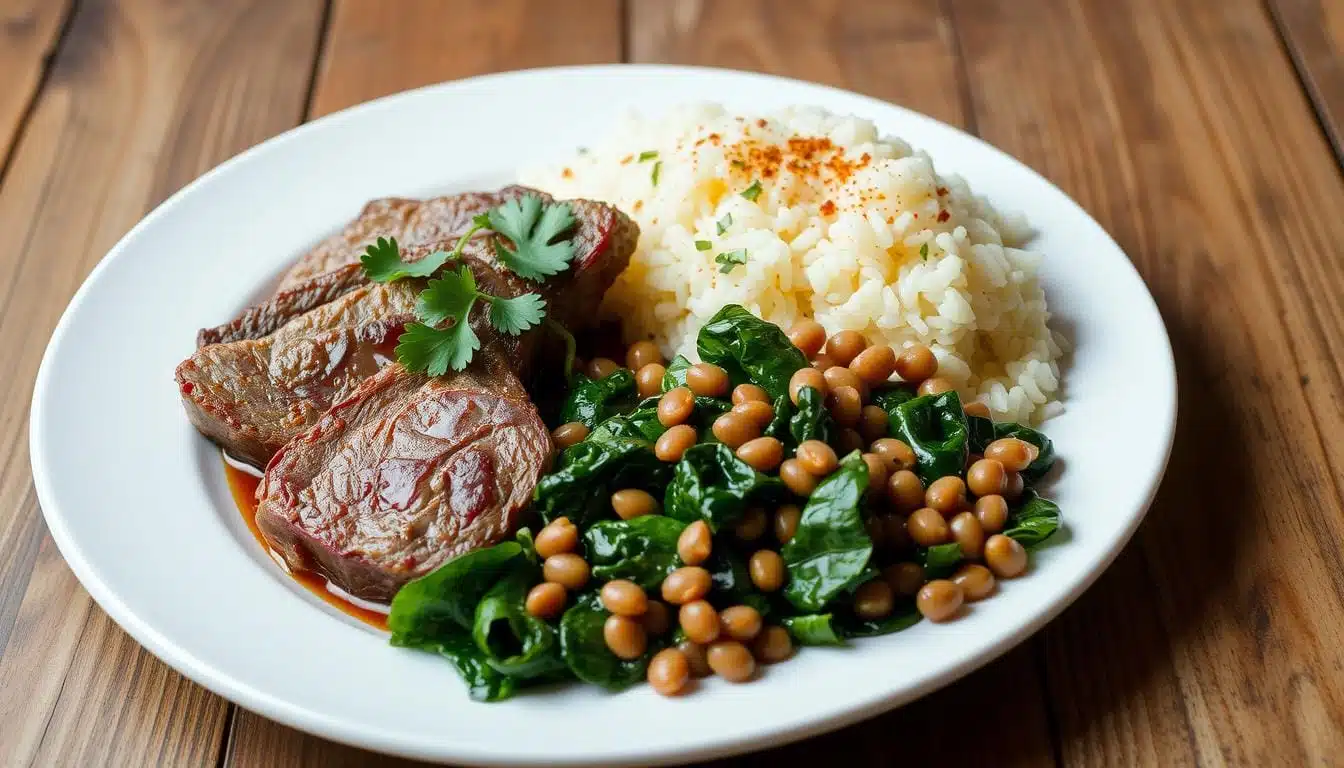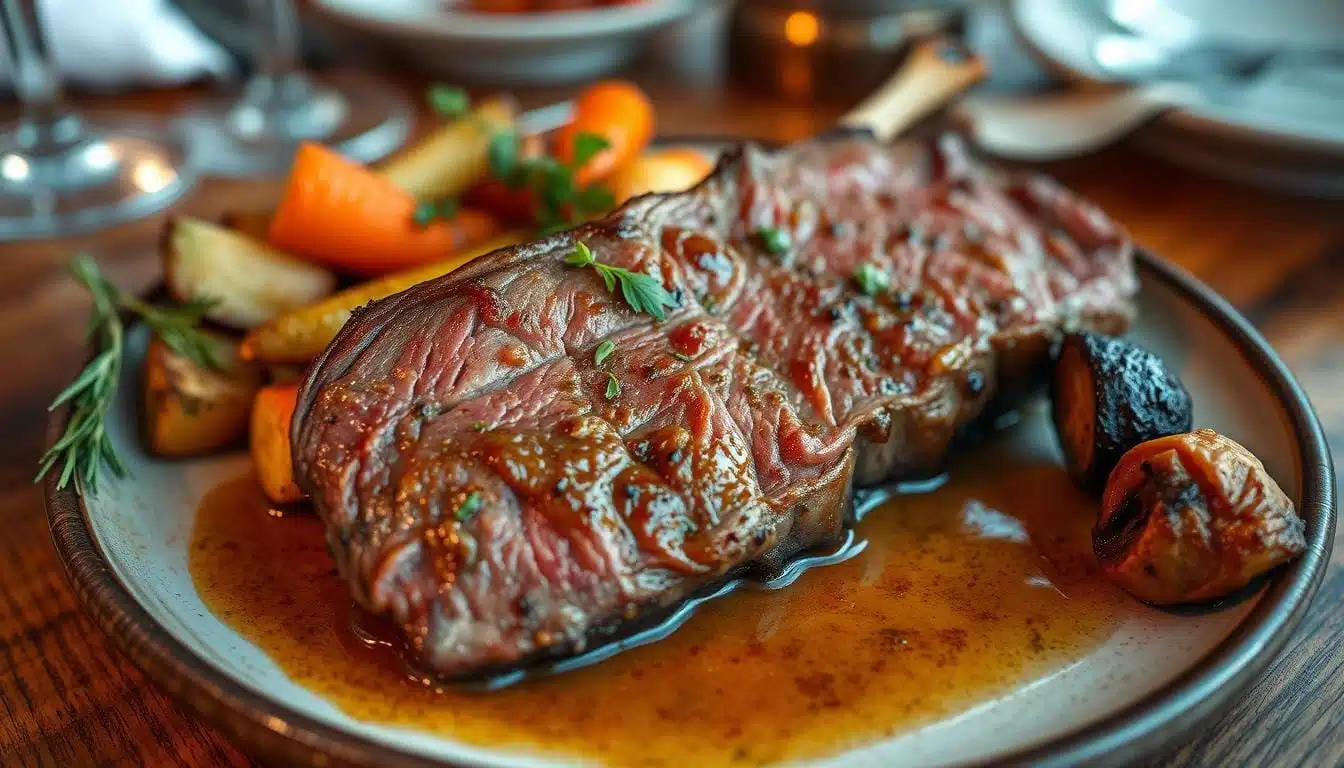Authentic Asian Street Meat: A Cultural Food Journey
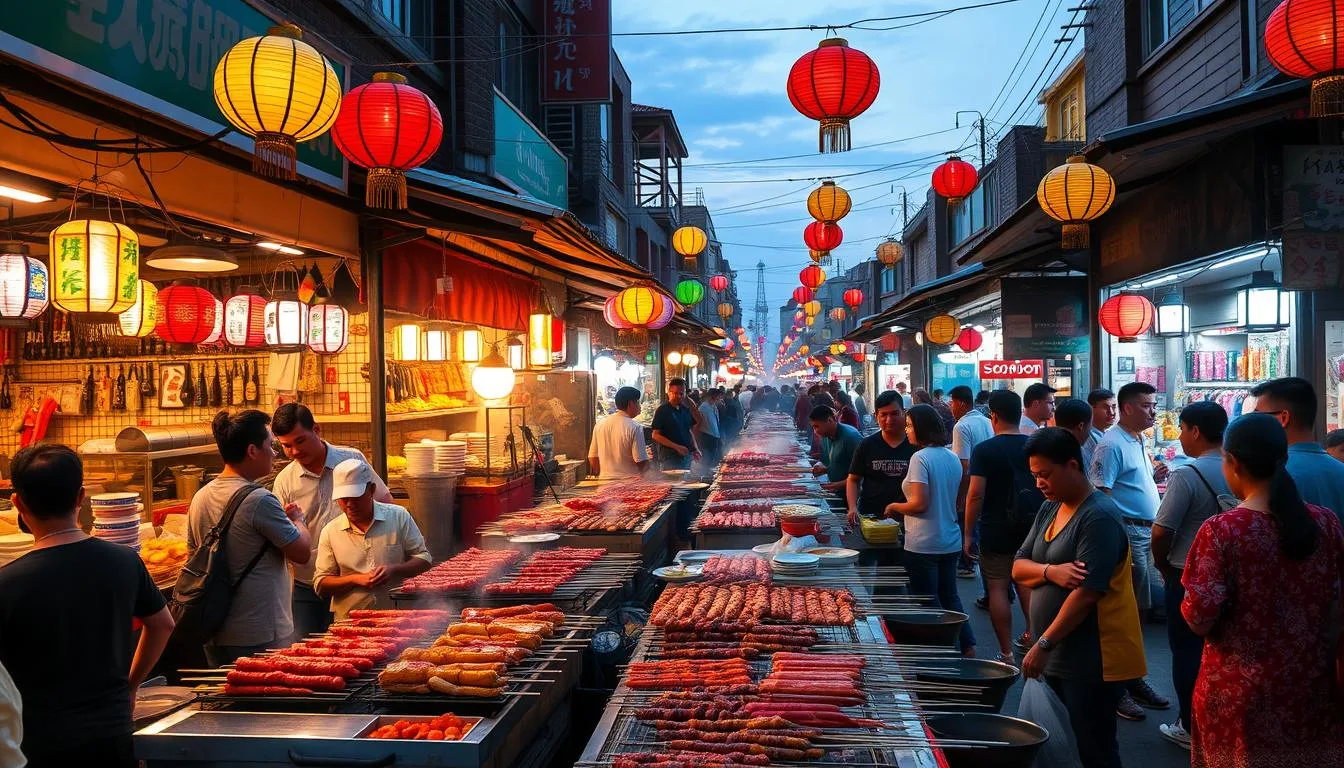
Have you ever wondered why millions around the world love Asian street food? It’s not just the grilled meats and spices. The street food scene in Asia is a cultural experience that goes beyond eating. From Bangkok’s night markets to Seoul’s alleyways, the street meat shows the rich culinary heritage of Asia.
Street food is a peek into local cultures. It’s shaped by history, geography, and local ingredients. For example, Thai Moo Ping balances flavors, while Japanese Yakitori focuses on natural meat tastes. Each dish tells a story of its people and traditions.
Join us on a journey through the world of authentic Asian street meat. Here, affordability meets deliciousness, with grilling, frying, and marinating techniques creating unforgettable tastes.
Table of Contents
sian Street Food Culture
Street food has been a beloved part of Asian culture for centuries. It’s where locals and travelers come together. The street food markets across Asia are more than just places to eat. They are a mix of flavors, traditions, and stories passed down through generations.
The asian street food culture is loved for its variety, ease of access, and the perfect blend of taste, tradition, and convenience.
Historical Evolution of Street Food Vendors
The history of street food markets in Asia goes back to ancient times. Itinerant vendors sold their local specialties from makeshift stalls. These vendors were key in feeding communities, offering tasty and affordable food.
Over time, the culinary heritage of street food has grown. Each new generation of vendors has adapted to changing tastes and needs.
The Social Significance of Street Food Markets
Asian street food markets are more than just places to eat. They are centers of social interaction and cultural exchange. These lively spots bring people together, creating a sense of community and shared experiences.
Locals and travelers share meals, stories, traditions, and culinary secrets. These shared moments have been a part of their lives for generations.
Cultural Exchange Through Street Cuisine
Cultures like Chinese, Japanese, and French have shaped the street food landscape in Asia. This mix of flavors and techniques has led to unique dishes like French-inspired banh mi sandwiches in Vietnam or Chinese-influenced char kway teow noodles in Malaysia.
These dishes show the power of cultural exchange. They prove how different cuisines can inspire and learn from each other.
“Street food is the heart and soul of Asian cuisine, offering a window into the rich culinary heritage and vibrant traditions of the region.”
Essential Asian Street Meat Cooking Techniques
The world of Asian street food is full of diverse cooking methods. These methods, from asian barbecue to street-side grills, are key to Asia’s street meat flavors.
In Southeast Asia, satay is a favorite. It’s made with chicken, beef, or lamb, marinated in turmeric, lemongrass, garlic, and coconut milk. Then, it’s grilled and served with a peanut sauce.
Thailand’s Moo Ping is another example. It’s grilled pork skewers with a sweet-savory marinade. The marinade includes fish sauce, garlic, cilantro root, and palm sugar. It’s often eaten with sticky rice.
In Japan, yakitori is all about grilling small chicken pieces. They’re grilled over high heat with a soy sauce-based sauce. This makes the meat taste great and adds a nice char.
Korea’s Bulgogi BBQ is a street food version of a traditional dish. It’s thinly sliced beef marinated in soy sauce, sesame oil, and sugar. It’s grilled and served in lettuce wraps or sandwiches.
India and Pakistan’s Seekh Kebabs are known for their seasoning. They’re made with ground lamb or chicken, seasoned with cumin, coriander, and chili powder. They’re grilled and served with mint chutney and naan.
These cooking methods highlight Asia’s rich culinary heritage. Street-side grills and portable woks make quick, flavorful asian barbecue and street meat. They’re perfect for busy city life.
“The true essence of Asian street food lies in the artistry of its preparation, where centuries-old techniques come together to create unforgettable flavors on the go.”
Popular Asian Street Meat Varieties Across Regions
In Southeast Asia’s night markets and East and South Asia’s street stalls, you’ll find a variety of dishes. These include asian meat skewers, braised dishes, and barbecued specialties. They show the rich diversity of Asian street food. These dishes offer a journey through the vibrant flavors and cooking techniques that locals and travelers love.
Grilled Meat Skewers and Satays
In Indonesia, Malaysia, and Singapore, satay is a common sight. It features skewers of chicken, beef, or lamb, marinated in turmeric, lemongrass, and coconut milk. Thailand’s Moo Ping, or grilled pork skewers, use a marinade of fish sauce, garlic, and palm sugar for a mix of salty, sweet, and smoky flavors.
Further north, Japanese yakitori and Korean bulgogi BBQ show East Asia’s regional specialties.
Braised and Stewed Meat Dishes
South Asia’s street stalls offer spicy seekh kebabs from India and Pakistan, and Bangladesh’s shami kebabs. These dishes highlight the bold flavors and aromatic spices of the region.
Barbecued Street Specialties
Exploring beyond well-known dishes, you’ll find many street meat specialties in Asia. The Philippines’ chicken inasal and Laos’ Ping Pa (grilled fish) are examples. Vietnam’s Bo La Lot (beef wrapped in betel leaves) also stands out. These dishes show the diversity and unique flavors of Asian street food culture.
| Dish | Region | Key Ingredients | Typical Price |
|---|---|---|---|
| Satay | Southeast Asia | Chicken, beef, or lamb skewers marinated in turmeric, lemongrass, and coconut milk | Varies by location, often 10-20 THB per skewer |
| Moo Ping | Thailand | Grilled pork skewers marinated in fish sauce, garlic, and palm sugar | Approximately 30-40 THB per serving |
| Seekh Kebab | South Asia | Spicy minced meat skewers, often made with lamb or beef | Varies by location, typically 50-100 INR per serving |
| Chicken Inasal | Philippines | Grilled chicken marinated in a blend of vinegar, lemon, and spices | Approximately 50-100 PHP per serving |
Night Markets: The Heart of Asian Street Meat
Night markets are the lively centers of Asia’s street food scene. They offer a wide range of grilled skewers, roasted treats, and local favorites. Places like Hoi An, Vietnam, and Singapore’s Maxwell Food Centre are famous for these markets. They let vendors share their cooking skills and family recipes.
Bangkok’s Chinatown and floating markets are known for their night markets and street food culture. The atmosphere is vibrant, prices are low, and the food variety is huge. Visitors can try delicious hawker fare, like BBQ meats, curries, and fresh street food. It’s a great way to dive into local culture.
These markets are more than just places to eat. They are social and cultural centers, attracting both locals and tourists. The lively vibe, diverse food, and sense of community make night markets a key part of Asian street food. They offer a memorable food journey.
| Night Market | Location | Highlights | Accolades |
|---|---|---|---|
| Raohe Street Night Market | Taipei, Taiwan |
|
|
| Shangri-la Horizon Cruise | Bangkok, Thailand |
|
|
Night markets are more than just places to eat. They are social and cultural centers, attracting both locals and tourists. The lively vibe, diverse food, and sense of community make night markets a key part of Asian street food. They offer a memorable food journey.
“Night markets are the heart and soul of Asian street food culture, where the aroma of sizzling meats and the lively chatter of vendors create an unforgettable sensory experience.”
Traditional Marinades and Seasonings in Asian Street Meat
The flavors of Asian street meat come from many marinades and seasonings. These vary by region, showing off local tastes and traditions. From lemongrass and coconut milk in Southeast Asia to soy sauces in Japan, each dish has its own special flavor and cultural story.
Regional Spice Blends
Spice blends in Asian street meat recipes change a lot by region. Indian and Pakistani kebabs use spices like cumin and coriander. Japanese yakitori has a soy-based tare sauce. Thai marinades mix sweet, salty, sour, and spicy flavors, often with lemongrass and fish sauce.
Secret Family Recipes
Many street food vendors keep their marinade and seasoning recipes secret. These recipes are passed down through generations. They help make each stall or region unique, adding to the rich flavors of street food.
Marination Techniques
Marinating meats for Asian street food is an old tradition. Vendors marinate for days, letting the spice blends soak into the meat. This careful process is key to the authentic taste of Asian street meat.
| Marinade Ingredient | Regional Association | Flavor Profile |
|---|---|---|
| Soy Sauce | East Asia | Savory, umami |
| Lemongrass | Southeast Asia | Citrusy, aromatic |
| Fish Sauce | Southeast Asia | Salty, pungent |
| Ginger | Across Asia | Spicy, warming |
| Coconut Milk | Southeast Asia | Creamy, rich |
“The unique flavors of Asian street meat are a testament to the region’s rich culinary heritage and the dedication of local vendors to preserving traditional recipes.”
Street-Side Grilling Methods and Equipment
The art of Asian street meat preparation uses portable, efficient cooking equipment. From the sizzling satay skewers of Southeast Asia to the smoky yakitori grills of Japan, street-side grilling is key. It’s a big part of the vibrant roadside cuisine.
Vendors use compact, mobile charcoal or gas grills for quick, consistent cooking. In Southeast Asia, satay stalls have long, narrow grills for many skewers at once. Japanese yakitori stalls use special charcoal grills for precise temperature control, making tender, charred chicken bites.
Korean street food vendors use flat griddles for bulgogi, ensuring even searing and caramelization of the thinly sliced beef. In Thailand and Vietnam, vendors mix grills and woks for a wide range of cooking techniques. This variety caters to the diverse array of street meat specialties.
| Cooking Method | Equipment Used | Regional Specialties |
|---|---|---|
| Grilling | Portable charcoal or gas-powered grills | Satay (Southeast Asia), Yakitori (Japan) |
| Griddle Cooking | Flat metal griddles | Bulgogi (Korea) |
| Combination Cooking | Grills and woks | Street meat specialties in Thailand and Vietnam |
The compact and mobile nature of these cooking setups lets street food vendors quickly set up. They can do this in busy markets or bustling street corners. This brings the sights, sounds, and aromas of authentic Asian street meat to eager customers.
“The open-flame cooking not only imparts a distinct smoky flavor but also creates an engaging visual experience for customers.”
From the sizzling satay to the charcoal-grilled yakitori, the street-side grilling methods and specialized equipment are crucial. They shape the rich and diverse flavors of roadside cuisine.
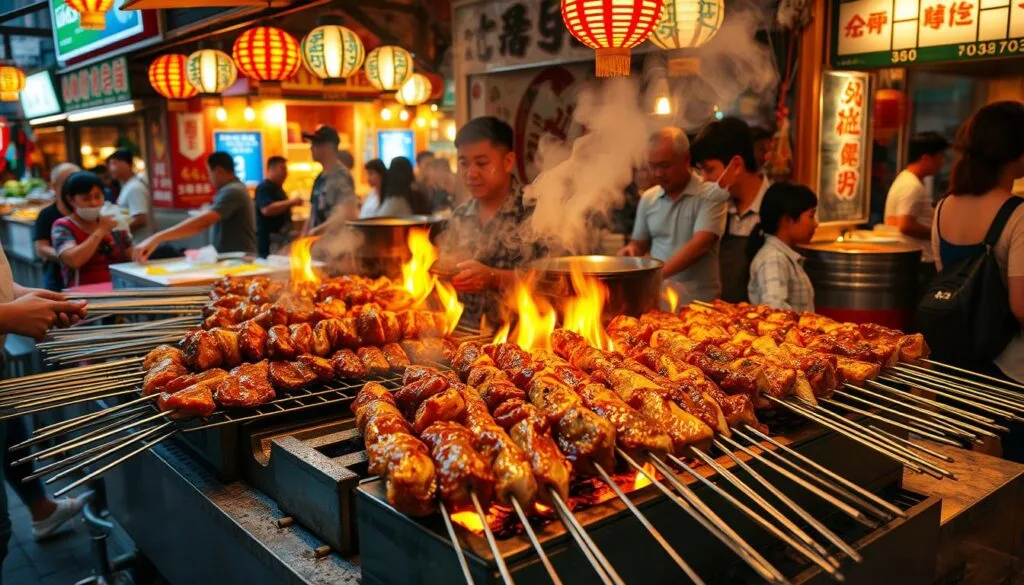
The Role of Asian Street Meat in Local Communities
Street food vendors are key to local economies in Asia. They offer jobs and support small businesses. Places like Singapore’s hawker centers and Thailand’s night markets provide affordable meals.
Street food stalls are community hubs. They foster social bonds and keep culinary traditions alive.
Economic Impact on Vendors
Street food vendors are crucial for families and small businesses. In Vietnam, communal dining is a big part of food culture. It strengthens family and social bonds.
Vietnamese bia hoi corners are lively spots. They connect locals and tourists over food and drinks.
Community Gathering Spaces
Street food areas are cultural centers. They are where locals and tourists share stories and enjoy authentic flavors. In Hoi An, Vietnam, street food offers a mix of culinary adventure and cultural immersion.
In Hong Kong, food goes beyond taste. It celebrates community and tradition. Dim sum and cha chaan tengs are examples of communal dining.
| Region | Popular Street Food | Cultural Significance |
|---|---|---|
| Vietnam | Phở, a noodle soup | Showcases rich flavors of ginger, herbs, and spices |
| Thailand | Pad Thai, a stir-fried noodle dish | Offers bold flavors that reflect the country’s culinary traditions |
| India | Chaat, a savory snack | An explosion of flavors and textures made from various ingredients |
Asian street food vendors do more than feed people. They have a big impact on communities and local economies. These lively spots are key to understanding the culture and traditions of their areas.
Health and Safety in Street Food Preparation
Asian street food is getting more popular, and keeping food safe is key. Many Asian cities are making rules to keep street food clean and safe. They want vendors to follow strict food handling and cleanliness rules.
In Singapore, famous hawker centers are known for their cleanliness. Thailand is teaching street food vendors about food safety. This includes keeping food at the right temperature and using clean water.
But, making sure all street food is safe is hard. Some places are starting to require licenses for street food sellers. This helps keep everyone safe and accountable.
| Region | Food Safety Initiatives | Challenges |
|---|---|---|
| Singapore |
|
|
| Thailand |
|
|
Street food is a big part of Asian culture. Keeping it safe and clean is very important. This is a big job for local authorities and vendors.
“Ensuring the safety and quality of street food is essential to protect public health and preserve the vibrant culture of these beloved culinary traditions.”
Sustainable Practices in Modern Street Food Vending
The world is waking up to the need for environmental care. The Asian street food scene is taking steps to be more eco-friendly. They’re using new packaging and managing waste better, showing the way to a greener future.
Eco-friendly Packaging Solutions
In Thailand, street food lovers enjoy their meals in biodegradable banana leaf wraps. This is a green choice instead of plastic. In Singapore, hawker centers are pushing for reusable containers. This move encourages vendors and customers to think about packaging in a new way.
Waste Management Initiatives
In Hoi An, Vietnam, street food sellers use local, eco-friendly ingredients. Taiwan and Hong Kong’s night markets now have recycling stations. These steps help cut down on plastic use and attract eco-aware visitors.
The call for sustainable street food is getting louder. Vendors are finding creative ways to be more eco-friendly. By choosing green packaging, managing waste, and using local ingredients, the Asian street food scene is paving the way for a greener future.
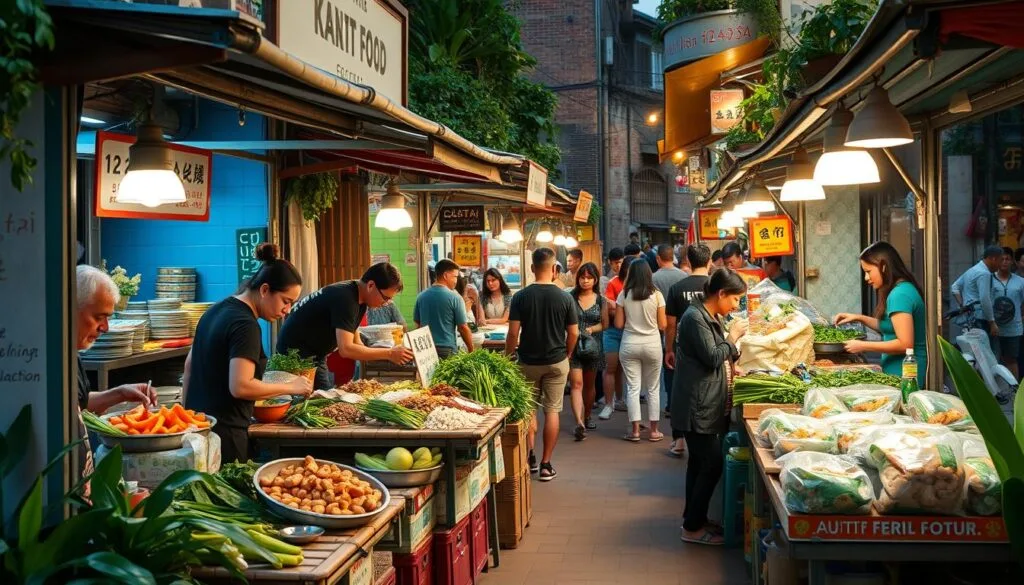
Street Food Tourism and Cultural Exchange
Street food is a big hit in food tourism across Asia. Culinary travel tours that focus on street food are getting more popular in places like Bangkok, Singapore, and Hanoi. These tours let tourists taste food and learn about local culture and history.
In Hoi An, Vietnam, cooking classes and market tours teach visitors about local ingredients and cooking methods. Food festivals, like the Singapore Food Festival, draw visitors from around the world. They celebrate street food and show off the region’s culinary heritage.
Street food tourism helps local economies and fosters cultural exchange. Travelers get to try real flavors and meet local vendors and communities.
- Southeast Asian restaurants have grown by 15-20% annually in key markets like North America and Europe.
- The National Restaurant Association in the U.S. has consistently placed Southeast Asian cuisines like Vietnamese, Thai, and Filipino in its top 10 restaurant trends in recent years.
- Social media platforms have significantly boosted the global awareness and popularity of Southeast Asian food culture.
| Dish | Description |
|---|---|
| Amok | A traditional Cambodian curry dish made with fish or chicken, coconut milk, and spices. |
| Beef Lok Lak | Stir-fried beef with tomatoes, onions, and a tangy lime-based sauce. |
| Kuy Teav | A popular noodle soup dish made with rice noodles, beef or seafood, and herbs. |
Talking to local street food vendors and communities offers a deep dive into Asian cuisines’ rich cultural heritage. By diving into food tourism and cultural experiences, travelers can truly appreciate the diversity and authenticity of these vibrant culinary traditions.
“Street food is a gateway to understanding the heart and soul of a culture.”
Fusion Trends in Contemporary Asian Street Meat
The world of Asian street food is changing fast. Chefs and vendors are mixing old flavors with new ones. This creates exciting dishes that everyone loves.
Modern Interpretations of Classic Dishes
In Singapore, hawker stalls are trying new things. They mix local flavors with global tastes. For example, they make ramen burgers and laksa pasta.
Global Influences on Traditional Recipes
Fusion street food is big everywhere. Korean-Mexican tacos are popular, mixing Korean and Mexican flavors. In Thailand, vendors add international spices to traditional dishes.
Japanese street food is also getting a twist. Takoyaki, with new fillings, is found in many places. These changes show how tastes are changing and how global influences are shaping Asian food.
“Fusion cuisine integrates diverse culinary traditions, sparking creativity and encouraging experimentation in contemporary cuisine.”
The fusion of Asian street food with global flavors shows how food is always changing. This fusion street food movement is a celebration of Asia’s rich food culture and the joy of sharing flavors.
Preserving Traditional Street Food Heritage
In Asia, the effort to save traditional street food is growing. Singapore’s hawker culture is now a UNESCO Intangible Cultural Heritage. This shows how important these lively street food markets are. In Vietnam, efforts are underway to save the traditional recipes that make street food in places like Hoi An special.
In Thailand, culinary schools teach street food cooking. Japan also has programs to help young chefs learn traditional street food ways. These efforts keep cultural identity alive and ensure authentic flavors and methods are shared with the next generation.
Preserving street food heritage is more than keeping things the same. It’s about finding a balance between respecting the past and moving forward. By recording recipes, training new vendors, and teaching these old techniques in schools, Asia’s street food heritage is protected for the future.
“The key to Thai street food’s deliciousness lies in the harmonious balance of sweet, sour, salty, bitter, and spicy elements.”
As more people around the world want to learn about traditional recipes and food preservation, these efforts are crucial. They help keep Asia’s street food culture real and lasting.
| Location | Preservation Efforts |
|---|---|
| Singapore | Hawker culture recognized as Intangible Cultural Heritage by UNESCO |
| Vietnam | Initiatives to document and preserve traditional street food recipes in Hoi An |
| Thailand | Culinary schools incorporate street food techniques into curricula |
| Japan | Programs to support and train young chefs in traditional street food preparation |
Conclusion
Asian street cuisine is more than just food. It shows the culture, social life, and new ideas of Asia. From Southeast Asia’s satay stalls to South Asia’s kebab vendors, it gives a real taste of local life.
The street food scene is changing, with more focus on being green and trying new things. Yet, it still keeps its traditional flavors and ways of cooking.
Asian street cuisine is a big part of food tourism and local economies. It helps people from all over connect and share in the culinary identity of Asia. The street food scene is a colorful way to see Asia’s rich heritage and creative spirit.
In the end, Asian street cuisine is a lively and changing food culture. It’s a way to learn about Asia’s unique stories, social lives, and food ways. Street food keeps drawing in people, showing the lasting charm of Asian food.


